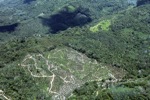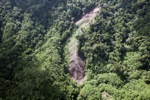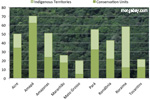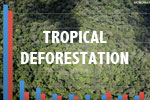
|
|
|
What is Deforestation?Deforestation refers to the cutting, clearing, and removal of rainforest or related ecosystems into less bio-diverse ecosystems such as pasture, cropland, or plantations (Kricher, 1997). What are the causes of deforestation? I. Logging II. Mining III. Oil and gas extraction IV. Cattle ranching V. Agriculture: Cash crops VI. Local, National, and International factors: development, land titles, government subsidies to attract corporations into developing countries, trade agreements (NAFTA, CAFTA), civil wars, debt, lack of resources, and lack of law enforcement.  Deforestation in Borneo. Photos by Rhett Butler Largest rainforests worldwide listed in descending order (from largest to smallest).
Facts:
Overview of deforestation around the world: Between 1960 and 1990, most of the deforestation occurred globally, with an increasing trend every decade.
 Destructive logging in Malaysia. Statistics on Global Rates of Rainforest Destruction: 2.4 acres (1 hectare) per second: equivalent to two U.S. football fields 149 acres (60 hectares) per minute 214,000 acres (86,000 hectares) per day: an area larger than New York City 78 million acres (31 million hectares) per year: an area larger than Poland On average, 137 species become extinct everyday; or 50,000 each year! *If the current rate of deforestation continues, the world's rain forests will vanish within 100 years- causing unknown effects on global climate and eliminating the majority of plant and animal species on the planet*  Small-scale deforestation in the Amazon. What are the consequences of deforestation? Environmental:
 Deforestation for palm oil production in Borneo. Social impacts:
 Oil Palm Estate and Rainforest in Malaysian Borneo. What can we do to STOP or at least lessen the amount of deforestation and conserve our own use of natural resources such as wood, oil and gas, electricity, minerals and elements, and water? Brainstorm...here's a start:
 Deforestation in Malaysian Borneo. Okay, now show YOURSELF what you have LEARNED by answering the following questions:
2. Why does deforestation happen? For what purpose(s)? 3. The largest rainforest in the world is located in: a.) The Philippines b.) The Congo Basin in Central Africa c.) Peru d.) The Amazon Basin of South America 4. If 2 U.S. football fields are destroyed every second, how many football fields are destroyed in 5 seconds? 5. If 50,000 species become extinct every year, how many will become extinct in half a year? 6. T or F: Rainforests contain over half of all plant and animal species in the world? 7. Fill in the blank: One environmental consequence of deforestation is __________. This occurs when heavy rains wash nutrients from the soil. 8. Name two things you can do as a global citizen to decrease deforestation. 9. Biodiversity refers to: a.) The loss of animals and plants b.) A variety, or many different kinds of living things c.) When animals lose their living space or habitat d.) An increase in the earth's temperature 10. Fill in the blank: Indigenous people _______ in the rainforest. They depend on the forest for their food, clothing, medicine, cooking and building materials.  Gold mining. Answers are located after the references (please don't look until you have completed all 10 questions). Pen Pal Letter: Imagine you're in class and your teacher reads an article about a U.S. company which is deforesting a rainforest in Brazil. Your teacher encourages you and your classmates to write letters to the company. Using the information you have learned in this lesson, write your letter to convince the company to STOP the deforestation. Use the facts you have learned to support and provide evidence for your position. Write your letter in the Comments Section after this lesson. You and your Pen Pal will read each other's letters and provide positive feedback to each other. References: Kricher, J. (1997). A Neotropical Companion: An introduction to the animals, plants, & ecosystems of the New World Tropics. New Jersey: Princeton University Press. Rainforest Action Network web-site: https://ran.org/info_center/factsheets/04b.html NASA web-site: https://eospso.gsfc.nasa.gov/ftp_docs/Deforestation.pdf Answers to questions: 1. Deforestation refers to the cutting, clearing, and removal of rainforest or related ecosystems into less bio-diverse ecosystems such as pasture, cropland, or plantations. 2. Logging, mining, oil and gas extraction, cattle ranching, agriculture, and International, National, and Local reasons. 3. d.) The Amazon Basin in South America 4. 2 U.S. football field= 1 second, then ? U.S. football fields= 5 seconds You can set it up as a proportion: 2/1= n/5, n=10 5. 1/2 of 50,000 or 1/2 x 50,000 or 50,000/2= 25,000 species 6. True 7. erosion 8. Buy paper products made from recycled paper and become a vegetarian 9. b.) A variety, or many different kinds of living things 10. live How did you do? I bet you did great!  Gold mining. Note: This integrated lesson is designed for 3rd grade students. The following California standards are addressed in this lesson: Reading: Vocabulary and Concept Development (1.6): Use sentence and word context to find the meaning of unknown words. Reading Comprehension: Comprehension and Analysis of Grade-Level-Appropriate Text (2.6): Extract appropriate and significant information from the text, including problems and solutions. Writing applications: Write personal and formal letters , thank-you notes, and invitations (2.3): Show awareness of the knowledge and interests of the audience and establish a purpose and context. Life Science: Students know when the environment changes, some plants and animals survive and reproduce; others die or move to new locations. Social Studies: Students understand the role of rules and laws in our daily lives and the basic structure of the U.S. government (3.42): Discuss the importance of public virtue and the role of citizens, including how to participate in a classroom, in the community, and in civic life. Algebra and Functions: Students select appropriate symbols, operations, and properties to represent, describe, simplify, and solve simple number relationships: (1.1): Represent relationships of quantities in the form of mathematical expressions, equations, or inequalities. About these lesson plans and resources This lesson plan was developed by Lisa M. Algee, an Environmental Education Ph D student at the University of California at Santa Cruz (UCSC). Lisa runs a site called Kids Connected to Conservation and Culture which focuses on educating the next generation about environmental issues, such as deforestation, and what we can do as global citizens to curb these detrimental effects. |
More deforestation photos Deforestation charts
|
|
home | teacher resources | rainforest books for kids | other languages | about the site | main rainforest site | help support the site | search | contact worldrainforests.com/kids is published under a creative commons license.  
©2004-2013 mongabay.com |







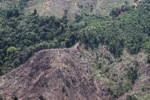
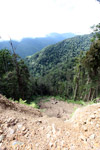






![Deforested peatlands in Borneo [kalbar_2254]](https://s3.amazonaws.com/mongabay/indonesia/150/kalbar_2239.jpg)
![Storm over the Amazon's agricultural landscape [brazil_0431]](https://pictures.butlernature.com/brazil/150/brazil_0431.jpg)





![Conversion of transition forest in the Brazilian Amazon [brasil_037]](https://pictures.butlernature.com/brazil/150/brasil_037.jpg)
![Newly cleared section of Amazon forest [brazil_0552]](https://pictures.butlernature.com/brazil/150/brazil_0552.jpg)



![Aerial view of a massive gold mining area in the Amazon [peru_aerial_1553]](https://s3.amazonaws.com/mongabay/peru/150/peru_aerial_1553.jpg)




![Deforested peat forest in West Kalimantan, Indonesia [kalbar_0013]](https://s3.amazonaws.com/mongabay/indonesia/150/kalbar_0032.jpg)
![Illegal logging operation in Borneo [kalteng_0215]](https://mongabay.s3.amazonaws.com/indonesia/150/kalteng_0215.jpg)




![Soy and forest fragments: the new landscape of the southern Amazon [brazil_0298]](https://pictures.butlernature.com/brazil/150/brazil_0298.jpg)





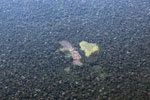

![Chopped down rainforest tree [kalbar_1038]](https://s3.amazonaws.com/mongabay/indonesia/150/kalbar_1083.jpg)
![Damage from a graphite mine near Mantandia [madagascar_1102]](https://mongabay.s3.amazonaws.com/madagascar/150/madagascar_1102.jpg)

